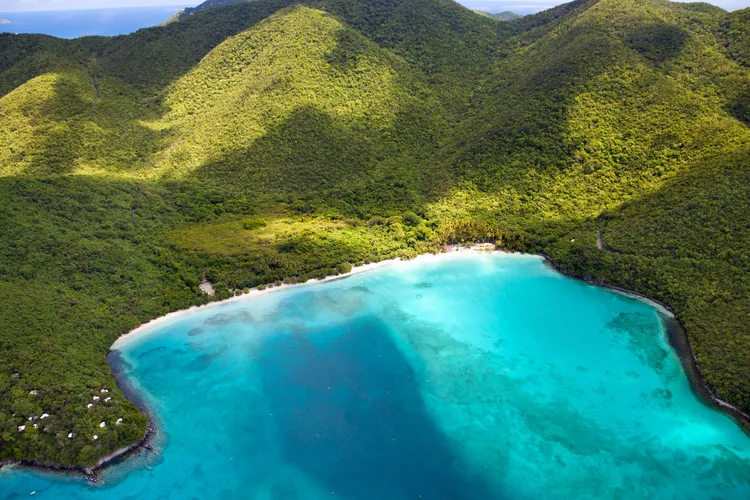Summary
Overview of Virgin Islands National Park
You don’t have to travel outside the United States to unwind on a white sandy beach surrounded by crisp, turquoise water. Located on the Caribbean land of St. John, Virgin Islands National Park is a small treasure offering the pleasures of island living to its visitors. The tropical feeling is intensified by more than 800 subtropical plant species growing in the high-elevation forests and mangrove swamps. Moreover, stunning coral reefs teeming with fragile plants and animals surround the island.
The Virgin Islands are an exciting place to explore through activities like boating, sailing, snorkeling, and hiking. Consequently, you can discover the beauty of this national park while enjoying one of the world’s most beautiful beaches.
History
Though Columbus sighted the islands in 1493, humans inhabited the area of the Virgin Islands long before his arrival. Archeological finds show that South Americans migrated northward and lived on Saint John as early as 770 BC. Later, Taino Indians utilized the sheltered bays for their villages.
In 1694, the Danes formally took possession of the island, attracted by the prospects of sugar cane cultivation. They established the first permanent European settlement on Saint John in 1718 at Estate Carolina in Coral Bay. By the early 1730s, production expanded remarkably, and 109 cane and cotton plantations were in operation.
As the plantation economy grew, so did the demand for slaves. However, the emancipation of slaves in 1848 led to the decline of the Saint John plantations. By the early 20th century, cane and cotton plantations transitioned to cattle and subsistence farming, along with rum production.
The United States purchased the island in 1917, and by the 1930s, ways to expand tourism were being explored. Rockefeller interests acquired land on Saint John in the 1950s and donated it to the Federal Government in 1956 to create a national park. On August 2, 1956, Virgin Islands National Park was officially established. The park originally comprised 9,485 acres on St. John and 15 acres on St. Thomas. In 1962, the boundaries were enlarged to include 5,650 acres of submerged lands, showcasing coral reefs, mangrove shorelines, and sea grass beds.
In 1976, the Virgin Islands National Park became part of the biosphere reserve network designated by the United Nations, making it the only biosphere in the Lesser Antilles. At that time, the park boundaries expanded again in 1978 to include Hassel Island located in St. Thomas harbor.
When to Visit
The park is open year-round, and the climate does not vary significantly throughout the year. However, it is essential to note that summer months can become quite hot. Hurricane season typically lasts from June through November, which may influence travel plans.
Getting There
To reach the park, take a plane to Charlotte Amalie in St. Thomas. From there, you can take a taxi or bus to Red Hook, where a 20-minute ferry ride across Pillsbury Sound to Cruz Bay is available. Alternatively, one can opt for one of the less frequently scheduled ferries from Charlotte Amalie, which takes around 45 minutes but docks closer to the airport.
Fees/Permits
While there is no entrance fee for the park, please note that there is a user fee to enter Trunk Bay: $5 for adults, while children aged 16 and younger enter for free.
Major Attractions
- Trunk Bay: This beach is considered one of the most beautiful in the world, featuring a 225-yard long underwater snorkeling trail. Facilities include a bathhouse, snack bar, souvenir shop, and snorkel gear rentals. Keep in mind that there is a day-use fee.
- Cinnamon Bay: This beach offers a water sports center that rents snorkel gear and windsurfing equipment. It also organizes day sailing, snorkeling, and scuba diving lessons.
- Ram Head Trail: This short yet rocky 0.9-mile trail, located off Saltpond Bay, leads visitors through a surprisingly arid environment, where several types of cacti and century plants can be seen.
- Annaberg: Once one of the larger sugar plantations on St. John, visitors can tour the remains of the windmill and horsemill that were once used to crush sugar cane. Cultural demonstrations such as baking and basket weaving take place Tuesday through Friday from 10 a.m. to 2 p.m.
- Reef Bay Trail: This trail descends through a steep valley into a subtropical forest over 2.5 miles. It showcases the ruins of former sugar estates, along with mysterious petroglyphs.
- Fort Frederik: Once owned by the king, this fort was part of the first plantation built by the Danes before being taken over by the French.
Accommodations
One campground is located within the park, with Cinnamon Bay open year-round. From December to mid-May, there is a 14-day limit on stays, while a 21-day limit applies for the rest of the year. Reservations are recommended and can be made by contacting 800-539-9998 or 340-776-6330.
Other accommodations are available on St. John. The St. John Inn offers economical rooms, while Gallows Point Suite Resort features 60 units with kitchens, a restaurant, and pool facilities.
For luxurious options, consider Caneel Bay, located at Cruz Bay, which offers 166 units priced between $450-$1,175 per night.
Areas of Interest Outside the Park
Buck Island Reef National Monument: Situated one mile north of St. Croix, this stunning coral reef encircles almost all of Buck Island. Visitors can take a marked underwater trail while snorkeling or on a glass-bottom boat to explore the unique ecosystem. Hiking trails are also accessible across 176 land acres, providing breathtaking views of St. Croix.
Open year-round, this national monument can be accessed by charter boat from Christiansted, St. Croix. For more information, call 340-773-1460.




